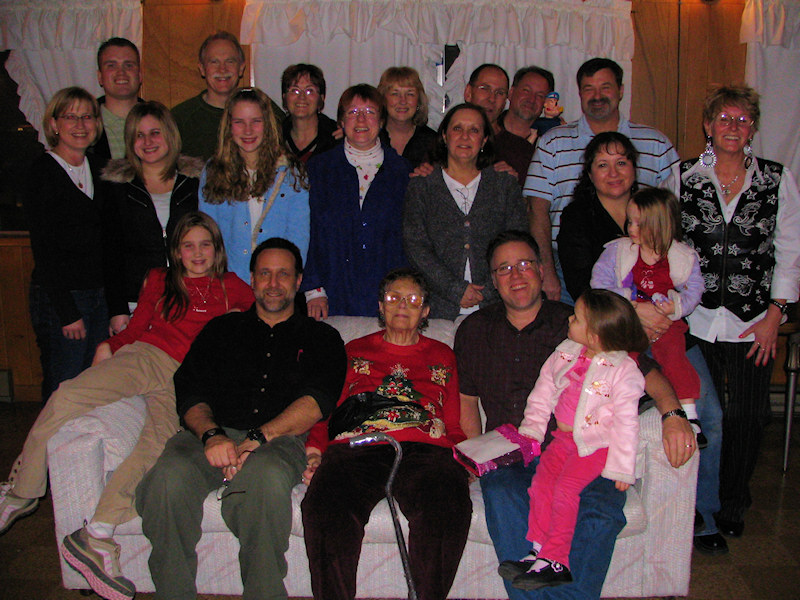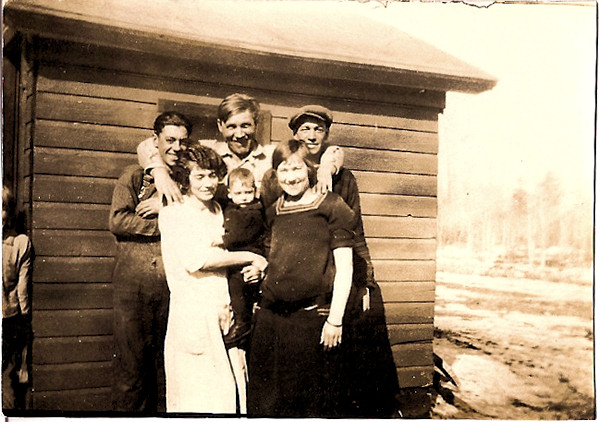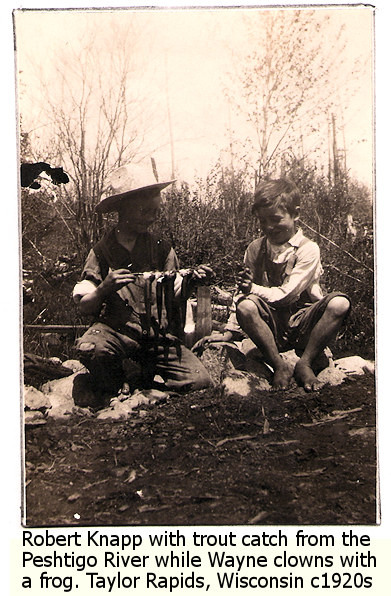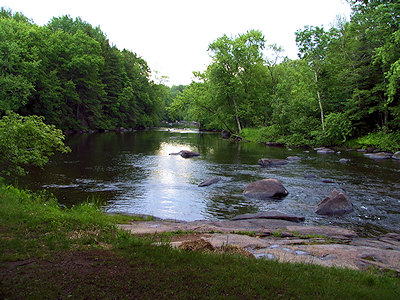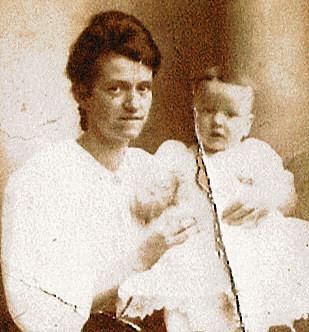On June 29, 1925, an earthquake shook most of the city and surrounding area of Santa Barbara, California, almost to the ground. On the Pacific Coast, backed by the Santa Ynez Mountains, and part of the famous California earthquake zone, the residents were rocked awake at 6:44 AM to an estimated 6.3 magnitude earthquake lasting 19 seconds.
“Again the continent shivered and stretched its right hip. Brick fell in the streets of Santa Barbara, buildings collapsed, hotels and banks were reported in ruins, the dam of one of the city’s reservoirs burst, telegraphic and telephonic connections severed, several were killed.”
Time Magazine, July 6, 1925
While roofs and walls cracked, chimney’s fell, and personal items crashed to the floor, most homes survived the earthquake. Commercial buildings and businesses didn’t fare as well, as many downtown buildings along State Street, including famous and popular hotels, collapsed and crumbled. The nearby Sheffield Dam, inside of the city limits, cracked apart, the only dam in the United States history to fail.
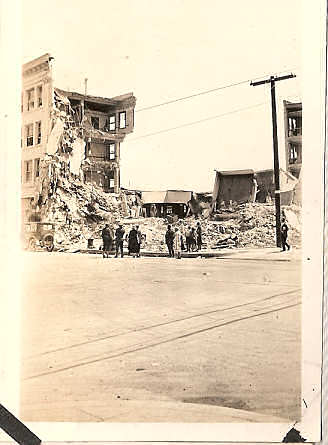
1925 Santa Barbara Earthquake, San Marcos Building Destroyed, Photograph by Howard W. West Sr.
According to reports, when the dam broke, a wall of water roared through Voluntario and Alisos Streets. Like a tsunami, the water shoved homes, trees, cars, and debris through the streets, filling up the lower part of town with two feet of water.
As devastating as the earthquake was the buildings and roads, totally over USD $20 million in damage, only 13 people died. The fact that most people were still at home and not at work was believed to prevent more people from being injured or killed.
Hundreds of families required help, and the National Red Cross came in with food, tents, and aid to the thousands of victims. More than 30,000 residents slept on lawns, in public parks, and on the beach until small tent communities were setup as citizens awaited the inspection and repair of their homes and businesses.
Many business owners opened up their restaurants, shops, and offices in tents around town and in front of their collapsed offices, determined to “get back to business as usual”.
According to the Official Earthquake Facts, the nearby city of Los Angeles sent 50 policemen immediately to aid the city, soon followed by more than 250 US Marines who helped maintain law and order, direct traffic, and help with the safety and recovery of the area.
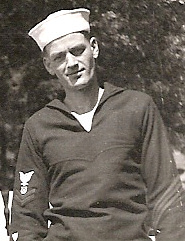
Howard William West Sr., circa 1930
My grandfather, Howard William West Sr., was among them.
Married just over one year and stationed on board the USS Arizona, 19 year old Howard West was part of the Marine troops responding to help the city. For about two months, he did his job, taking time during the breaks to wander the town, photograph the wreckage, and collect newspaper clippings about the Marines’ welcome presence. While many of his photographs have been ruined or lost to time, I’ve posted a few here, along with transcriptions and digital images of the preserved newspaper clippings from local Santa Barbara and Marine base papers.
The aftershocks continued for months after the initial earthquake. Many Santa Barbara residents spent most of the summer camped out in their yards for fear of another “big one”.
Santa Barbara rebuilt itself and is still known as the “Riviera” of the West Coast with Spanish Colonial style homes and buildings with red tile roofs and white stuccoed walls. Many credit the earthquake as giving the city a chance to rebuild with stricter codes and regulations, with emphasis on creating a more styled, uniformed Spanish village architecture, creating the popular tourist destination as it is today.
For more information on the 1925 Santa Barbara Earthquake, see:
Leathernecks at Santa Barbara
From the local Santa Barbara newspaper, circa June 1925
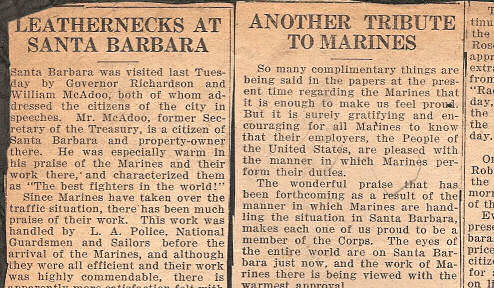
Newspaper article from Santa Barbara newspaper, circa June 1925
Santa Barbara was visited last Tuesday by Governor Richardson and William McAdoo, both of whom addressed the citizens of the city in speeches. Mr. McAdoo, former Secretary of the Treasury, is a citizen of Santa Barbara and property owner there. He was especially warm in his praise of the Marines and their work there, and characterized them as “The best fighters in the world!”
Since Marines have taken over the traffic situation, there has been much praise of their work. This work was handled by L.A. Police, National Guardsmen and Sailors before the arrival of the Marines, and although they were all efficient and their work was highly commendable, there is apparently more satisfaction felt with the manner in which Marines perform this important duty. Without being unnecessarily “hardboiled” they are able to maintain strict discipline, and their authority is exercised discreating, and therefore highly respected.
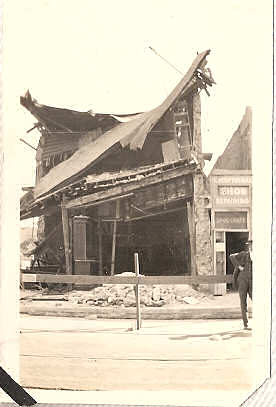
Building next to shoe shop in Santa Barbara destroyed, photograph by Howard W. West Sr. 1925
The work of the Red Cross in Santa Barbara is especially appreciated by the Marines. At all hours of the day and night the sentries are provided with coffee and sandwiches by Red Cross workers.
Santa Barbara showmen acted as hosts to the Marines last Monday night, in presenting a movie show for them. As it was the only show in town, and the first one since the disaster, many civilians also attended.
A canteen was opened on the encampment, and is doing a rushing business. Bootblack boys thronged the camp, and pressing, laundering, mending, equipment clean services have been established.
Many Santa Barbara merchants have placed signs in their windows calling the attention of the passerby to the fact that in Santa Barbara everybody and everything is serene and orderly, and that business is “as usual.”
Those reading “Still smiling and Ready to Serve,” are numerous, but the most original one is posted over the Goldfish Cafe on State Street, and reads as follows:
GOLDFISH CAFE
DOWN BUT NOT OUT
Twenty-two Years in Business and
No. 1 – San Francisco, 1906, Earthquake and Fire, completely cleaned out.
No. 2 – Flood, 1921, San Antonio Texas, completely cleaned out.
No. 3 – Santa Barbara Earthquake, 1925.
STILL ALIVE AND DOING BUSINESS
Another Tribute to Marines
From local Marine newspaper, July 1925
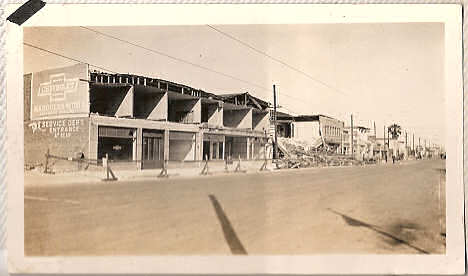
El Camino Hotel and a main street in Santa Barbara after earthquake
So many complimentary things are being said in the papers at the present time regarding the Marines that it is enough to make us feel proud. But it is surely gratifying and encouraging for all Marines to know that their employers, The People of the United States, are pleased with the manner in which Marines perform their duties.
The wonderful phrase that has been forthcoming as a result of the manner in which Marines are handling the situation in Santa Barbara just now, and the work of Marines there is being viewed with the warmest approval.
The article which follows appeared in the issue of the July 8th, of the Santa Ana Daily Evening Register, under the title “Santa Barbara Thankful for Marines’ Aid”:
“In the services that they now are giving the stricken city of Santa Barbara, the U.S. Marines, dubbed the ‘devil dogs’ during the war, have added new laurels to their long record of gallant service and distinguished achievements, according to Earl Busby, manager of Hotel Santa Ana, who returned yesterday from the channel city.
“Busby, who lived in Santa Barbara before coming here, has considerable property in that city, including two residences. Mrs. Busby and two daughters, Misses Beryl and Dorothy Busby, now are in Santa Barbara.
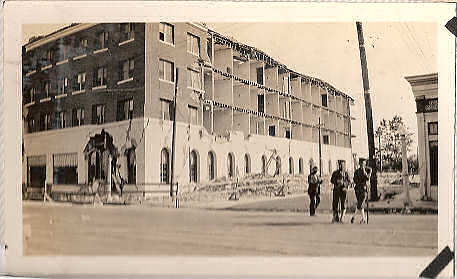
Apartment or hotel in Santa Barbara destroyed by earthquake, with Marines in the street.
“Speaking of the service given by the Marines, the hotel man said that the sea-soldiers certainly are living up to their reputation to be the best disciplined, most effective, and result-getting police force in the world, barring none – not even New York’s ‘finest’ and the London ‘bobbies’.
“For military purposes, Uncle Sam’s Marines already have established a fighting reputation second to none in the United States defense forces.
“‘Never before were life and property so well protected as they are today with the Marines patrolling the city,’ Busby remarked, voicing his approval of the manner in which the fighting men are performing their duties.
“‘Courtesy seems to be the second nature of these men,’ he added, ‘and they were going about their work without that gruff, hard-boiled attitude towards citizens that some people think is indispensable to efficient police work.
“‘I cannot begin to express the appreciation that the people of Santa Barbara feel for the service given by the Marines, and if they had their own way about it, they would never let them go.'”
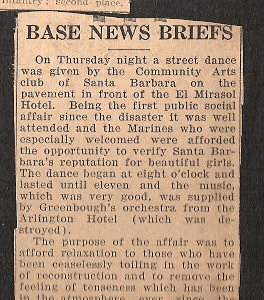
Newspaper article clippings from local Marine base newspapers, circa June – July 1925
Base News Briefs
Collection from the local Marine base newspapers, different issues, circa June-July 1923
On Thursday night a street dance was given by the Community Arts club of Santa Barbara on the pavement in front of the El Mirasol Hotel. Being the first public social affair since the disaster it was well attended and the Marines who were especially welcomed were afforded the opportunity to verify Santa Barbara’s reputation for beautiful girls.
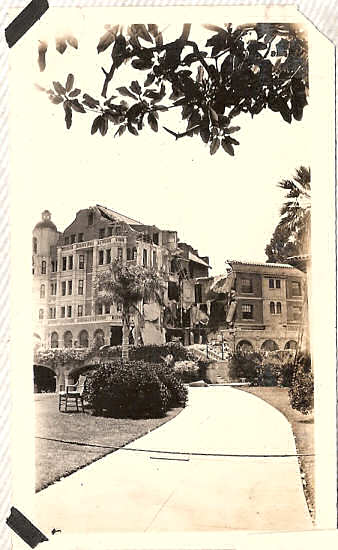
Arlington Hotel in Santa Barbara after earthquake
The dance began at eight o’clock and lasted until eleven and the music, which was very good, was supplied by Greenbough’s orchestra from the Arlington Hotel (which was destroyed).
The purpose of the affair was to afford relaxation to those who have been ceaselessly toiling in the work of reconstruction and to remove the feeling of tenseness which has been in the atmosphere ever since the quake. The Marines attended in force and despite the difficulty encountered in having to dance with leggings on, they were all enthusiastic and acclaimed it a wonderful dance.
On Wednesday, July 8th, Admiral Robertson and Colonel Meyers spent the day in Santa Barbara and in the morning made an informal inspection of the encampment.
Everybody seems to appreciate the presence of the Marines in Santa Barbara. The merchants make special prices to Marine customers and busy citizens find time to stop a moment for a word or two with the Marine on liberty.
Automobile rides are not lacking and it is seldom that the Marine walking between town and the encampment is not hailed by the passing motorist and asked to ride.
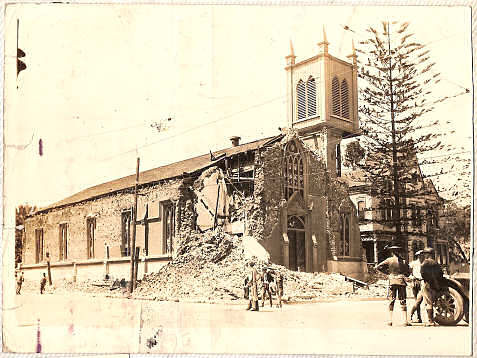
Our Lady of Sorrow Church in Santa Barbara after earthquake with Marines standing guard.
Santa Barbara is living up to its “Business as Usual” slogan and State Street is losing its devastated appearance. Steam shovels are cleaning away the bricks and debris and workmen are commencing to repair the buildings. Gas, electricity, and telephone are being reinstalled, broken display windows are being filled with plate glass, and the stores are opening. Already one theater and three large restaurants are doing business and the rest are operating in tents and temporary quarters. The Red Cross has closed its Canteen from dawn until dark, opening only at night. This last can be regarded as the most important sign of the return to normalcy. Santa Barbara has practically recovered from its “shakeup”.
When Do We Go Home
From the local Marine base newspaper, circa July 1925
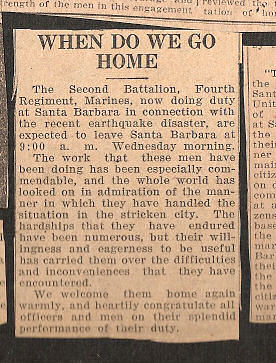
Newspaper article clippings from local Marine base newspapers, circa June – July 1925
The Second Battalion, Fourth Regiment, Marines, now doing duty at Santa Barbara in connection with the recent earthquake disaster, are expected to leave Santa Barbara at 9:00 a.m. Wednesday morning.
The work that these men have been doing has been especially commendable, and the whole world has looked on in admiration of the manner in which they have handled the situation in the stricken city. The hardships that they have endured have been numerous, but their willingness and eagerness to be useful has carried them over the difficulties and inconveniences that they have encountered.
We welcome them home again warmly, and heartily congratulate all officers and men on their splendid performance of their duty.
Marines Landed
From the local Marine Base newspaper, circa July 1925
“The finest uniformed body in the world.” is the statement of Santa Barbara citizens towards the United States Marine Corps. Some of the Marines who were on duty at Santa Barbara have returned to the local base, but the memory of their courtesy and efficient manner in the stricken city will remain for a long time with the citizens of that city. There is now on duty at Santa Barbara but one company, and these men were left at an urgent request of the citizens. Officers of the local marine base are loud in their praises for the splendid work done by the marines, and the citizens of Santa Barbara have publicly expressed their appreciation of the work of the feathernecks. Resolutions by the mayor and high praise by the citizens in general have been forwarded to the major general commandant at Washington.
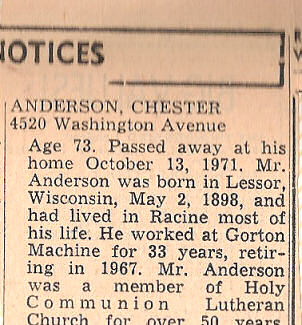 Age 73. Passed away at his home October 13, 1971.
Age 73. Passed away at his home October 13, 1971. 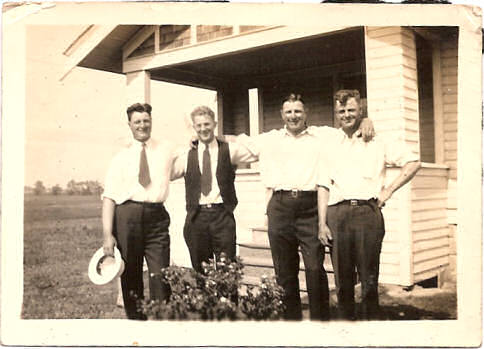

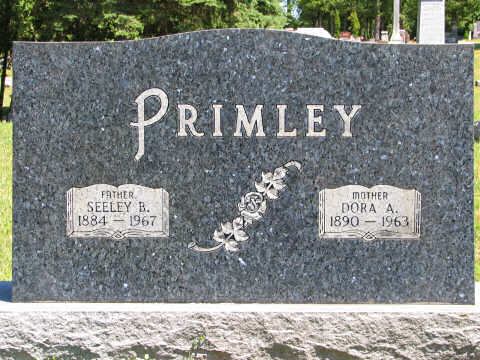
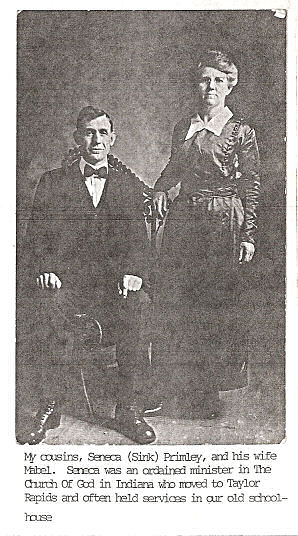
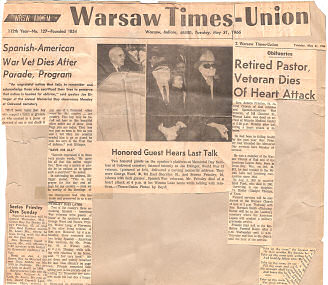










 Project Gutenberg, with the cooperation of many other eBook publishers, is currently sponsoring a
Project Gutenberg, with the cooperation of many other eBook publishers, is currently sponsoring a 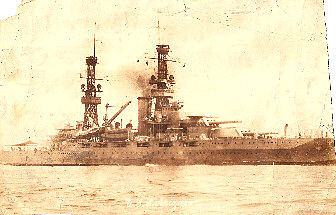 This narrow perspective on my country’s military history was very evident when I was teaching English in Israel. A Russian student and I were reading a letter from one of my god children about studying the Civil War in school. My student asked, “Which civil war?” I told him, “The Civil War.” He patiently, and actually in pretty good English, informed me that there have been a lot of civil wars in the history of the war, so which civil war was I talking about.
This narrow perspective on my country’s military history was very evident when I was teaching English in Israel. A Russian student and I were reading a letter from one of my god children about studying the Civil War in school. My student asked, “Which civil war?” I told him, “The Civil War.” He patiently, and actually in pretty good English, informed me that there have been a lot of civil wars in the history of the war, so which civil war was I talking about.